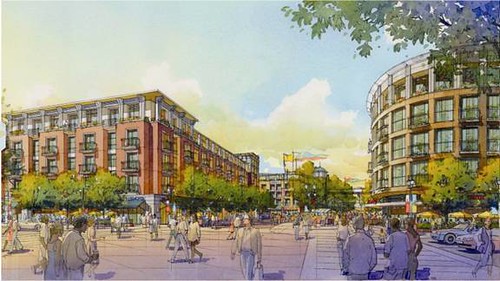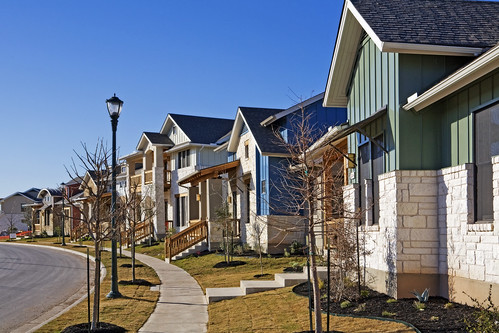How LEED-ND standards reduce driving and associated emissions: new research

Posted June 12, 2013 at 1:31PM
Confirming previous analysis, newly published research indicates that real estate development located, designed and built to the standards of LEED for Neighborhood Development will have dramatically lower rates of driving than average development in the same metropolitan region. In particular, estimated vehicle miles per person trip for twelve LEED-ND projects that were studied in depth ranged from 24 to 60 percent of their respective regional averages. The most urban and centrally located of the projects tended to achieve the highest shares of walking and transit use, and the lowest private vehicle trip lengths.
Put another way, even the “worst” performing of the LEED-ND projects is predicted to generate 40 percent less driving than an average development in its metropolitan region, according to the study’s sophisticated transportation models. This is largely because LEED-ND, a development rating system based on a set of voluntary standards, guides projects to locate within or adjacent and connected to already urbanized areas, and to be designed with walkable streets and densities. LEED-ND also rewards transit access, with increasing credit given to projects served by more frequent and plentiful transit options.
The study, led by well-known transportation expert Reid Ewing from the University of Utah, with four research colleagues, was published in April in the Journal of Planning Education and Research. The authors correctly summarize the essence and innovation of LEED-ND:
“Elements of smart growth, New Urbanism, and green building form the foundation of LEED-ND, producing a rating system that values compact, connected neighborhoods located near existing developed areas, and containing green buildings and infrastructure. For the first time under a LEED program, the location, context, and pattern of land development matters as much as the design of individual buildings.”
The authors discuss a number of criticisms of LEED-ND, including some made by me when the system was being considered for approval by the governing bodies of its founding organizations (NRDC, the Congress for the New Urbanism, and the US Green Building Council). Certainly, the system is not perfect and neither NRDC nor the industry groups got everything they wanted in the exhaustive (and exhausting) multi-year deliberations that produced the system. My ultimate concluson at the time, however, was that the system was nonetheless very good and deserved our enthusiastic support. It still does. LEED-ND is designed to be updated and improved periodically.
In the newly published research, the Ewing-led team first examined 239 “diverse mixed-use developments in six diverse regions” (Atlanta, Boston, Houston, Portland, Sacramento, and Seattle) in order to refine predictive models for estimating transportation behavior. "Multilevel modeling" was used to estimate internal capture of trips within the developments, walking and transit use for external trips, and trip length for external automobile trips. The team also generated separate formulas for different trip characteristics, depending on whether or not a trip was home-based, and whether or not it was work-related.
For the purposes of this article, suffice it to say that the development of the researchers’ transportation model was complex, sophisticated, and not for the technically timid to understand fully. But, utilizing a validation exercise comparing actual vehicle counts against those predicted by the refined model, the researchers concluded that “the new methodology far outperforms the conventional trip generation methodology of the Institute of Transportation Engineers.”
The team then predicted walking and transit mode shares and private vehicle trip lengths for the twelve selected projects and, from these, approximate vehicle miles of travel (VMT) per trip for each. In the final step, the team “analyzed the potential VMT reduction associated with those projects relative to a regional average baseline.”
For this reader, the study confirmed once again that shortening driving trip distances through central locations (as in redevelopment sites) is the single most important thing we can do to reduce vehicle miles traveled and associated carbon and other emissions. Working for mode shifts (for example, from driving to transit or walking) alone is unlikely to produce robust changes in behavior. Only three of the twelve projects had predicted walk mode shares of more than 15 percent, and the highest predicted transit mode shares were around 10 percent (still more than twice the national average; the authors concede that their ability to estimate transit mode share was limited and actual performance might be substantially higher).
But the differences between predicted driving trip lengths and the regional averages were dramatic. Even the highest predicted average driving trip length for the LEED-ND projects (about 5 miles) “is low by the standards of conventional sprawl development. Taken together, these LEED-ND pilot projects appear to generate relatively little VMT.” In other words, LEED-ND can be a powerful planning tool for reducing carbon emissions from driving. (Most of the research was conducted in 2010 but the study is just now being published.)
The newly published study is highly consistent with preliminary analysis conducted by Eliot Allen of Criterion Planners in Portland. Allen was the lead technical consultant in the development and testing of LEED-ND; analyzing the locations of LEED-ND pilot projects, he found in 2007 that the locations of the participating LEED-ND projects were associated with approximately double the density, double the transit commute share, and double the walk/bike commute share than were urban areas as a whole.
In 2010 Allen published a hypothetical demonstration analysis showing how a project taking advantage of LEED-ND’s carbon-saving credits and achieving certification at the gold level might avoid the generation of some 12,000 pounds of carbon per capita per year, a 30 percent reduction overall (including a 25 percent reduction in carbon from transportation) from a baseline development.
The good news is that Allen’s preliminary analysis suggesting that LEED-ND projects likely will reduce carbon emissions compared to average developments has now been reinforced by newly published research. The even better news is that the new, more in-depth analysis by Ewing and his colleagues now predicts that following the guidance of LEED-ND will likely result in even lower driving rates, and thus greater avoidance of carbon emissions, than did Allen's analysis.
Related posts:
- How to use LEED-ND to improve an older neighborhood (October 16, 2012)
- Knowing when it's green: A Citizen's Guide to (LEED for) Neighborhood Development (May 25, 2011)
- 5 ways that local groups and citizens can use LEED-ND (January 24, 2011)
- How LEED-ND identifies the best places for development and planning (September 13, 2010)
- The definitive study of how land use affects travel behavior (June 4, 2010)
- LEED for Neighborhood Development formally launches to promote smart, sustainable land use (April 29, 2010)
Move your cursor over the images for credit information.
Please also visit NRDC’s sustainable communities video channels.


